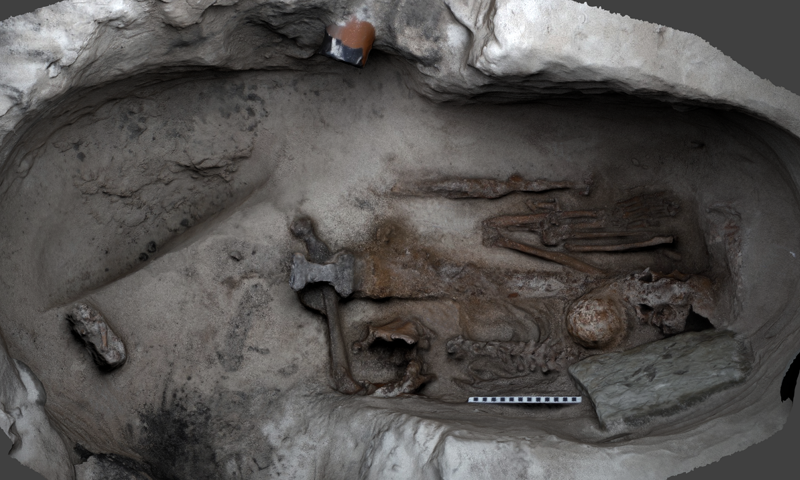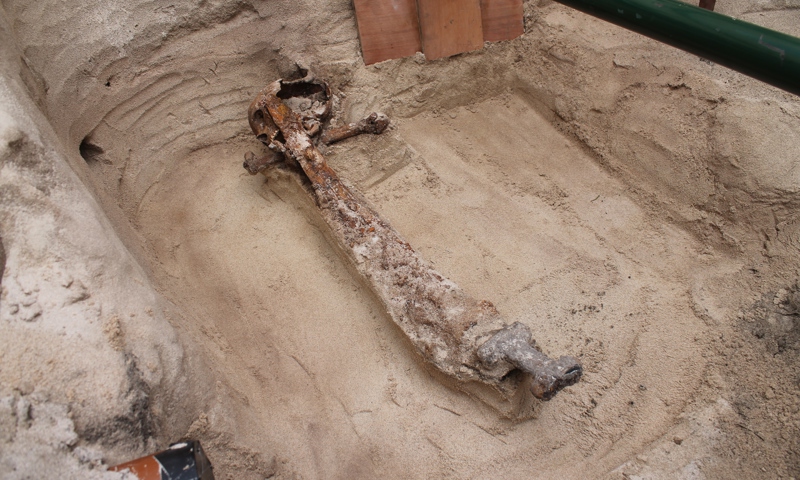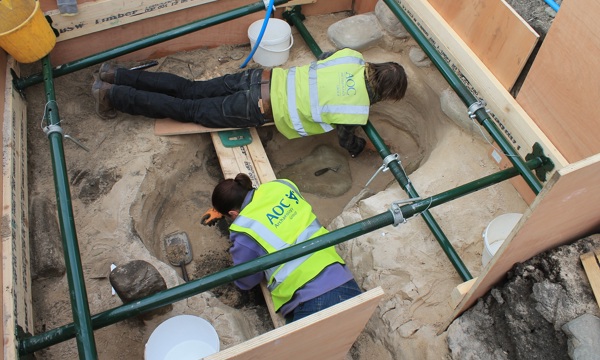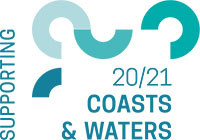Historic Environment Scotland (HES) is funding post-excavation analysis on two recently discovered Viking graves that may form part of a previously unknown cemetery uncovered in Orkney, to unlock stories of Viking life in Scotland over a thousand years ago.
⚠️ Warning: This article contains images of human skeletons. These images have been selected by us to illustrate points raised in the article which would be difficult to describe without the inclusion of images of human remains. Recognised ethical guidance on digital imaging and human remains was consulted before this decision was taken.
In 2015, human remains were discovered on the northeast coast of Papa Westray, Orkney. Further investigation determined that these discoveries were in fact the remains of Viking Age burials. Excavations revealed a number of significant finds, including evidence of a rare Viking boat burial, and a second grave richly furnished with weapons including a sword. Similarities with the type of burials and grave furnishings to those previously uncovered suggest the Papa Westray graves may be those of first-generation Norwegian settlers on Orkney.

Still from a 3D model showing the excavation of Mayback III, a pagan Norse grave. The placement of the sword and shield boss overlying the skeleton has provided an amazing opportunity to study the clothing the individual was buried in as organics such as textiles, leather and wood have been mineralised by the corroding iron. © AOC Archaeology
Archaeologists from AOC Archaeology are now working to analyse the discovery using a range of cutting-edge scientific techniques, with the hope of gaining new insights into the life and death of the Viking community in Orkney during the 10th century. The project will include a detailed programme of osteological work (bone analysis) and radiocarbon dating to help determine the age of the remains, as well as expert conservation and analysis of the grave artefacts that were unearthed.

The burial was meticulously block lifted from the grave where it will be further excavated in laboratory conditions, ensuring as much evidence as possible is preserved. In this photo most of the skeleton has been carefully lifted, with only the iron sword and the skull and arm bone it is resting upon still to be recovered. © AOC Archaeology
HES will also be working with the Ancient Genome Project to undertake genetic analysis of the discoveries to determine further information about the individuals in the graves, including genetic ancestry and sex, as well as to gain information on their diet and mobility.
Dr Kirsty Owen, Deputy Head of Archaeology at HES, said:
“We are delighted to be funding the work on this exciting project with AOC Archaeology, which we hope will shed new light on the Viking communities in Orkney during the 10th century.
“Many of the Viking burial sites we know of in Orkney were excavated in the late 19th and early 20th century.
This is a rare opportunity to investigate this discovery with the cutting-edge methods and techniques available to us today.
“We look forward to sharing our findings as the analysis continues, which we hope will enhance our understanding of the rich Viking heritage of Orkney and reveal more about the people who lived on these islands over one thousand years ago.”
Dr Ciara Clarke, Deputy Managing Director of AOC Archaeology, said:
“We are excited to be embarking on this project and look forward to working with HES, and an enthusiastic team of experts including Dr Stephen Harrison of Glasgow University, to record, study and analyse the evidence contained in these Viking Age burials.
The programme will help us to understand these individuals, their lives and their culture, telling us more about life in Orkney during the 10th century.
"We will be able to compare and contrast the evidence to other Scottish examples, as well as to similar sites from across the wider Viking world.”
HES will be updating on progress and results regularly throughout the year as the work continues.
About Year of Coasts and Waters 2021
The Year of Coasts and Waters (#YCW2021), led by VisitScotland, will be showcased throughout 2021. Activities and ideas will shine a spotlight on the impact our waters have had on Scotland, from the formation of beautiful natural features to the creation of our national drink - whisky.
About Historic Environment Scotland (HES)
- We are the lead public body charged with caring for, protecting and promoting the historic environment. We will lead on delivering Scotland’s first strategy for the historic environment, Our Place in Time.
- Historic Scotland, Scran, Canmore, The National Collection of Aerial Photography (NCAP), The Engine Shed, Stirling Castle and Edinburgh Castle are sub-brands of HES.
- View our press pack and keep up to date by registering for media release email alerts. If you wish to unsubscribe, please contact us.
Follow Historic Environment Scotland
Twitter: @HistEnvScot | @welovehistory
Facebook: @HistoricEnvScotland | @VisitHistoricScotland
Instagram: @HistEnvScot | @historicscotland
For further information, please contact:
Dean Hendry
Historic Environment Scotland Media Office
Mobile: 07221 959 962
communications@hes.scot


